2
Laryngeal Anatomy
The interpretation of laryngeal imaging in the evaluation of patients with voice problems requires a strong foundation in the anatomy and physiology of the larynx. Practitioners interested in maximizing the information obtained from laryngeal imaging must be familiar with laryngeal anatomy. To that end, this chapter reviews basic laryngeal anatomy with an emphasis on structures seen from a superior view of the larynx, as that is the view typically obtained from imaging techniques currently in use.
The larynx is a structure supported by a cartilage framework, lined by mucosa, and suspended from the hyoid bone (Fig. 2.1). The primary purpose of the larynx is to act as a sphincter. It is designed to protect the distal airway from ingested material and saliva and to regulate airflow into and out of the airway. The larynx is also designed to maintain airway patency. The cricoid cartilage is the only complete cartilaginous ring supporting the airway (Fig. 2.2). Lastly, the larynx functions in voice production.
 Laryngeal Cartilages
Laryngeal Cartilages
The laryngeal cartilages not only provide structural support for the larynx but also move relative to one another to control vocal fold position, length, and tension. The thyroid cartilage is shaped like a shield with a right and left lamina fusing in the midline (Fig. 2.3). The thyroid and cricoid cartilages interdigitate at the cricothyroid joint, which is located at the inner surface of the inferior-posterior aspect of the thyroid cartilage. The cricoid cartilage sits inside the posterior aspect of the thyroid cartilage. It projects below the thyroid cartilage anteriorly (Figs. 2.1 and 2.4). The cricothyroid joint is a synovial articulation allowing the thyroid cartilage to rotate forward and backward on the attachment to the cricoid cartilage. The cricoid cartilage is shaped like a signet ring with the wide lamina located posteriorly (Figs. 2.2 and 2.4).
Sitting on the superior surface of the posterior cricoid lamina are the paired arytenoid cartilages. The arytenoid cartilages are pyramidal in shape with the vocal processes located anteriorly and the muscular processes located laterally. The vocal ligament of the vocal folds attaches to the vocal processes of the arytenoids cartilages (Figs. 2.5 and 2.6). The intrinsic laryngeal muscles that act to open and close the vocal folds attach to the muscular processes of the arytenoid cartilages laterally. The arytenoid cartilages articulate with the cricoid cartilage through a joint that allows the arytenoids to both swivel and slide relative to the cricoid cartilage. Their movement is responsible for adduction and abduction of the vocal folds. Finally, the epiglottis is a leaf-shaped, elastic cartilage that is attached to the inner surface of the thyroid cartilage just above the anterior attachment of the vocal folds. This attachment is known as the petiole or thyroepiglottic ligament. The epiglottis flips down to cover the entry to the larynx during swallowing.
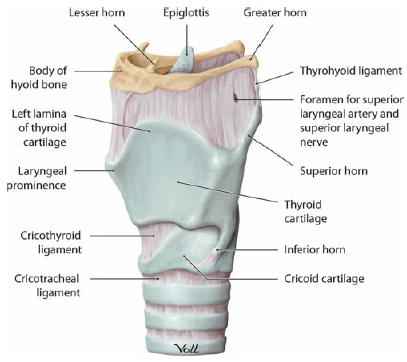
Fig. 2.1 Anterior-oblique view of the larynx. Note laryngeal cartilages are suspended from the hyoid bone via the thyrohyoid membrane. The cricoid cartilage is inferior to the thyroid cartilage along the anterior aspect of the larynx. The cricothyroid membrane spans the space between the two cartilages. (From THIEME Atlas of Anatomy, Neck and Internal Organs, © Thieme 2006. Illustration by Markus Voll.)
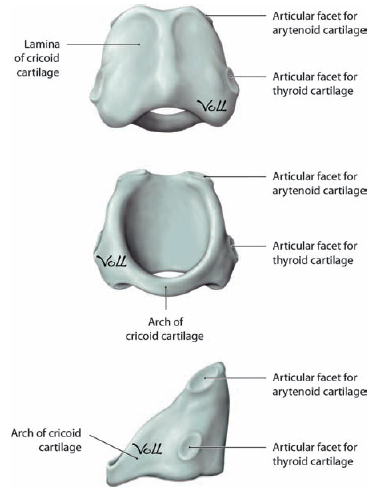
Fig. 2.2 Cricoid cartilage. (A) Posterior view, (B) anterior view, (C) left lateral view. (From THIEME Atlas of Anatomy, Neck and Internal Organs, © Thieme 2006. Illustration by Markus Voll.)
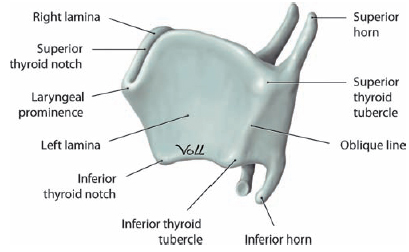
Fig. 2.3 Thyroid cartilage, left lateral view. (From THIEME Atlas of Anatomy, Neck and Internal Organs, © Thieme 2006. Illustration by Markus Voll.)
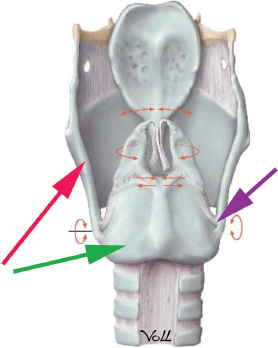
Fig. 2.4 Posterior view of the larynx. Note the relationship of the thyroid cartilage (red arrow) to the cricoid cartilage (green arrow). The purple arrow indicates the location of the cricothyroid joint. (From THIEME Atlas of Anatomy, Neck and Internal Organs, © Thieme 2006. Illustration by Markus Voll.)
 Laryngeal Membranes
Laryngeal Membranes
The larynx is suspended from the hyoid bone by the thyrohyoid membrane. The thyrohyoid membrane is pierced by the superior laryngeal nerve and artery. The cricothyroid membrane runs between the anterior inferior margin of the thyroid cartilage and the anterior superior margin of the cricoid cartilage (Fig. 2.1).
 Laryngeal Intrinsic Musculature
Laryngeal Intrinsic Musculature
The intrinsic laryngeal musculature attaches to the laryngeal cartilages, moving them relative to one another and thereby controlling the position, tension, and the length of the vocal folds (Figs. 2.7 to 2.9).
The lateral cricoarytenoid muscle is the primary adductor of the vocal folds. The fibers of this muscle attach to the muscular process of the arytenoid cartilages and run anteriorly and inferiorly to insert in the superior aspect of the cricoid cartilage. Muscle contraction pulls the muscular process of the arytenoids cartilages forward (and slightly downward), which, in turn, rotates the vocal processes of the arytenoids cartilages medially, closing the vocal folds (Figs. 2.7 and 2.8).
Abduction of the vocal folds results from contraction of the posterior cricoarytenoid muscles. These muscles also attach to the muscular process of the arytenoid cartilages and then run posteriorly to fan out and insert near the midline on the posterior aspect of the cricoid lamina. Shortening of the posterior cricoarytenoid muscle fibers moves the muscular process of the arytenoid cartilages posteromedially. This results in movement of the vocal processes laterally and abduction of the vocal folds (Figs. 2.7 to 2.9).
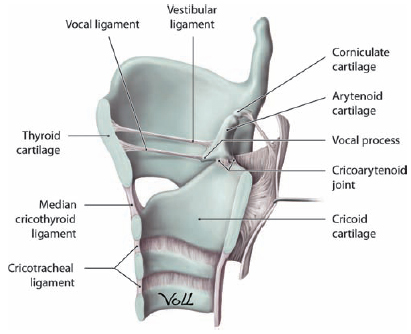
Fig. 2.5 Sagittal view of the interior of the larynx illustrating the relationship of the arytenoid cartilage to the cricoid cartilage. Note that the vocal ligament runs between the vocal process of the arytenoid cartilage and the inner surface of the thyroid cartilage. (From THIEME Atlas of Anatomy, Neck and Internal Organs, © Thieme 2006. Illustration by Markus Voll.)
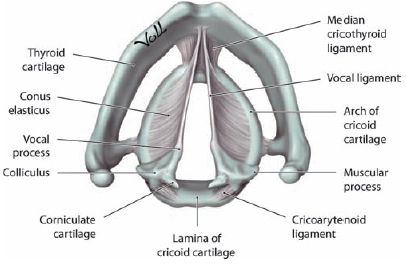
Fig. 2.6 Superior view of laryngeal cartilages. Note the position of the muscular process of the arytenoid cartilage.(From THIEME Atlas of Anatomy, Neck and Internal Organs, © Thieme 2006. Illustration by Markus Voll.)
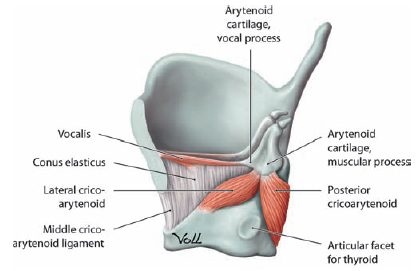
Fig. 2.7 Lateral view of the arytenoid and cricoid cartilages with the thyroid cartilage cut away. Note the lateral cricoarytenoid muscle runs from the muscular process of the arytenoid cartilage to the superior border of the cricoid cartilage. The posterior cricoarytenoid muscle runs from the muscular process of the arytenoid to the midline of the posterior lamina of the cricoid cartilage. (From THIEME Atlas of Anatomy, Neck and Internal Organs, © Thieme 2006. Illustration by Markus Voll.)
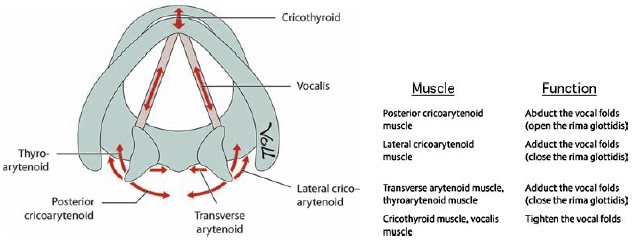
Fig. 2.8 Illustration of how the intrinsic laryngeal muscles act to move the laryngeal cartilages as viewed from above. (From THIEME Atlas of Anatomy, Neck and Internal Organs, © Thieme 2006. Illustration by Markus Voll.)
The thyroarytenoid muscles attach to the anterior surface of the arytenoid cartilages and insert into the inner surface of the thyroid cartilage. They make up the “body” of the true vocal folds and are responsible for control of “tension” in the folds. In other words, contraction of these muscles results in greater resistance to airflow through the glottis during phonation allowing the buildup of subglottic pressure and subsequent increases in vibratory amplitude and vocal volume. These muscles are also likely involved in pitch regulation as their contraction may lead to “shortening” of the vocal fold length (Fig. 2.7). The medial belly of the thyroarytenoid muscle is also known as the vocalis muscle (Fig. 2.7).
The muscles considered the most important in pitch regulation are the cricothyroid muscles. These muscles attach to the outer surface of the inferior margin of the thyroid cartilage and insert on the anterior and superior aspect of the cricoid cartilage. Contraction of the cricothyroid muscles causes the thyroid cartilage to rock forward on the cricoid cartilage. This movement increases the distance between the vocal processes of the arytenoid cartilages and the thyroid cartilage, lengthening and tensing the vocal folds (Figs. 2.10 and 2.11).
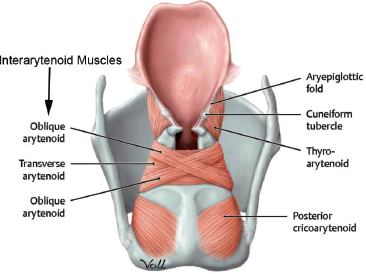
Fig. 2.9 Posterior view of the larynx illustrating the medial attachment of the posterior cricoarytenoid muscle. (From THIEME Atlas of Anatomy, Neck and Internal Organs, © Thieme 2006. Illustration by Markus Voll.)
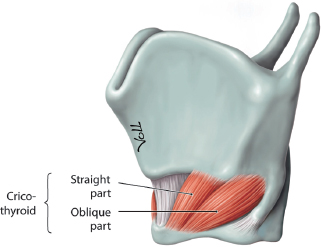
Fig. 2.10 Cricothyroid muscle. (From THIEME Atlas of Anatomy, Neck and Internal Organs, © Thieme 2006. Illustration by Markus Voll.)
The interarytenoid muscles run between the arytenoid cartilages and help to close the posterior glottis during voicing. Contraction of the interarytenoid muscles approximates the arytenoid cartilages. These muscles are innervated by both recurrent laryngeal nerves and will remain functional in cases of unilateral vocal fold paralysis secondary to recurrent laryngeal nerve palsy. The result is some movement of the arytenoid cartilage on the affected side due to contraction of the bilaterally innervated interarytenoid muscles, often confused with early signs of recovery (Fig. 2.9).
 Laryngeal Surface Anatomy
Laryngeal Surface Anatomy
The clinical examination of the larynx is typically from above with a view of the superior surface of the laryngeal structures. It is therefore the laryngeal surface anatomy that is most pertinent to the clinical examination of the larynx and the use of laryngeal imaging. The entry into the larynx is called the vestibule. The vestibule is defined by the fold of mucosa at the tip of the epiglottis, the superior aspect of the aryepiglottic folds, and the top of the arytenoid cartilages (Fig. 2.12).
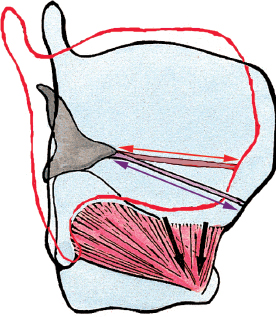
Fig. 2.11 Contraction of the cricothyroid muscle causes the thyroid cartilage to rotate forward and approximate the cricoid cartilage anteriorly. This movement increases the distance between the vocal processes of the arytenoid cartilages and the inner surface of the thyroid cartilage. As a result, the vocal fold elongates. The purple arrow depicts the relative length of the vocal fold before the cricothyroid muscle contracts and the red arrow depicts the increased length of the vocal fold with cricothyroid muscle contraction. (From Moore KL, Dalley AF. Clinically Oriented Anatomy, 5th ed. Baltimore: Lippincott Williams & Wilkins; 2006:1094.)
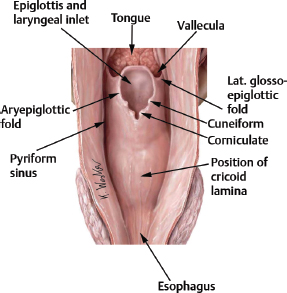
Fig. 2.12 Laryngeal surface anatomy: posterior view of laryngeal vestibule. (From THIEME Atlas of Anatomy, Neck and Internal Organs, © Thieme 2006. Illustration by Karl Wesker.)
The Glottic Opening and the True Vocal Folds
The opening between the vocal folds during abduction is referred to as the glottis or the glottic opening. The margin of the glottic opening created by the edges of the vocal folds is called the rima glottis. The membranous portion of the vocal folds accounts for the anterior 52% of the margin of the rima glottis, and the cartilaginous portion of the vocal folds makes up the posterior 48% of the margin of the rima glottis (Fig. 2.13).1 The rima glottis can only be adequately examined while the vocal folds are open, such as during quiet respiration. This also allows examination of the subglottic airway. It must be kept in mind that the under-surface of the vocal folds cannot be seen from a superior angle of view.
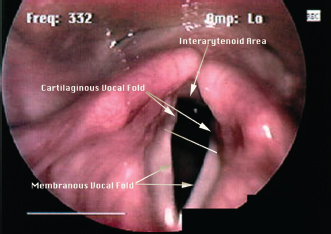
Fig. 2.13 Superior view of the larynx from imaging study. White bar over glottic opening defines the junction between the membranous portion of the vocal folds and the cartilaginous portion of the vocal folds.
The membranous portion of the vocal folds is the portion of the vocal folds that vibrates during phonation and consists of the thyroarytenoid muscle and overlying lamina propria and epithelial covering. (Please see Chapter 3 for a more detailed discussion of the membranous vocal fold histology.) Healthy membranous vocal folds usually appear white in color and glistening with moisture. The membranous portion of the vocal folds inserts anteriorly in the midline into the thyroid cartilage. This area is referred to as the anterior commissure. Posteriorly, the membranous portion of the vocal folds inserts into the vocal process of the arytenoid cartilage. The cartilaginous portion of the vocal folds is created by the medial surface of the arytenoid cartilage and the overlying mucosa (Figs. 2.14 and 2.15). The interarytenoid portion of the rima glottis refers to the area between the arytenoid cartilages. The interarytenoid contours are the result of the interarytenoid muscles and overlying mucosa (Fig. 2.13).
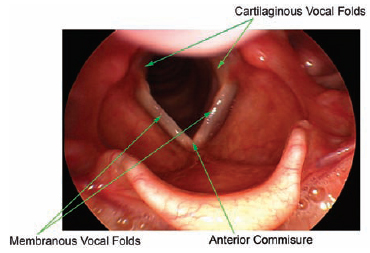
Fig. 2.14 Larynx viewed from above, vocal folds abducted.
The Quadrangular Membrane, the Ventricular Folds, and the Aryepiglottic Folds
The ventricular or “false” vocal folds and the aryepiglottic folds are the result of a sheet of connective tissue known as the quadrangular membrane. The quadrangular membrane is a rectangular sheet of connective tissue that attaches to the lateral margin of the epiglottis anteriorly and runs posteriorly to connect to the lateral margin of the arytenoid cartilage (Figs. 2.15 to 2.17). It is actually the inferior edge of the quadrangular membrane that creates the structure of the ventricular folds, and it is the superior edge of the quadrangular membrane that creates the superior margin of the aryepiglottic folds (Fig. 2.16). The laryngeal mucosa drapes over this connective tissue to create the folds. Within the superior margins of the aryepiglottic folds are located two small cartilages that act as batons, or stiffeners of the aryepiglottic folds. Those cartilages are the corniculate and cuneiform cartilages that sit at the apex of the arytenoids cartilages (Figs. 2.12 and 2.18).
The space between the superior surface of the true vocal folds and the ventricular fold is the ventricle. With a view from above, the contents of the ventricle cannot be evaluated as it is under the ventricular fold (Figs. 2.16, 2.17, and 2.19).
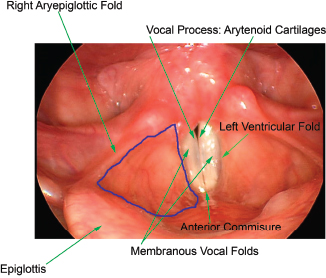
Fig. 2.15 Larynx viewed from above, vocal folds adducted. The location of the quadrangular membrane is outlined in purple.
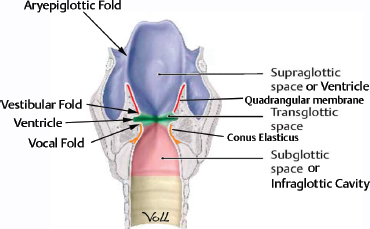
Fig. 2.16 Laryngeal surface anatomy: coronal view. Note the conus elasticus and its role in shaping the vocal fold contour and the quadrangular membrane and its role in shaping the aryepiglottic fold and the ventricular fold. (From THIEME Atlas of Anatomy, Neck and Internal Organs, © Thieme 2006. Illustration by Markus Voll.)
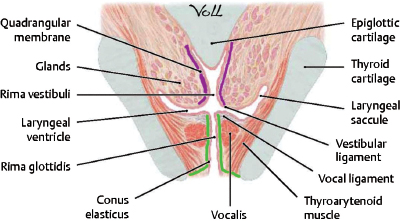
Fig. 2.17 Histologic rendering of a coronal view. Quadrangular membrane is indicated in purple and conus elasticus in green. (From THIEME Atlas of Anatomy, Neck and Internal Organs, © Thieme 2006. Illustration by Markus Voll.)
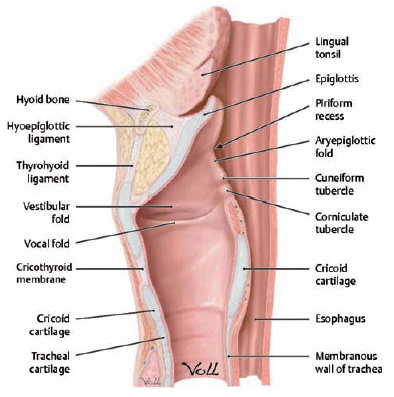
Fig. 2.18 Sagittal section of the larynx demonstrating the laryngeal surface anatomy. (From THIEME Atlas of Anatomy, Neck and Internal Organs, © Thieme 2006. Illustration by Markus Voll.)
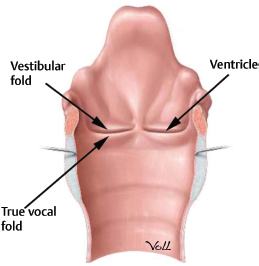
Fig. 2.19 Larynx opened from posterior midline to allow visualization of ventricular fold, ventricle, and vocal fold margin. (From THIEME Atlas of Anatomy, Neck and Internal Organs, © Thieme 2006. Illustration by Markus Voll.)
The Conus Elasticus and the Vocal Ligament
The true vocal folds contain connective tissue known as the vocal ligament. The ligament makes up the deep layer of the lamina propria and is involved in the attachment of the thyroarytenoid muscle to the connective tissue, that is, the lamina propria. The vocal ligament is the superior margin of another sheet of connective tissue known as the conus elasticus. The conus elasticus is attached to the inner surface of the cricoid cartilage and fans superiorly and medially to provide shape and contour to the undersurface of the vocal folds (Figs. 2.6, 2.16, and 2.17). It runs deep to the epithelial covering of the vocal fold and superficial to the deep musculature of the larynx.
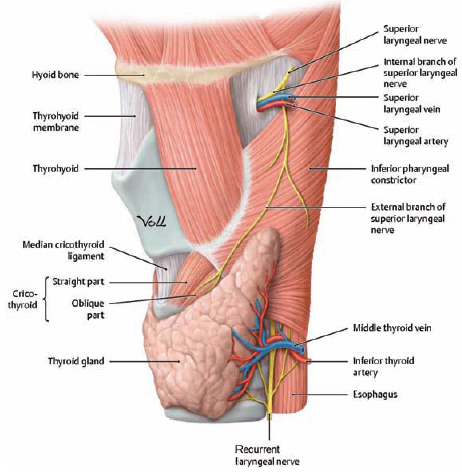
Fig. 2.20 Anterior-oblique view of the larynx demonstrating the course of the recurrent laryngeal nerve as it enters the larynx from the tracheo-esophageal groove. The external branch of the superior laryngeal nerve provides motor branches to the inferior laryngeal constrictor and the cricothyroid muscle. The internal branch of the superior laryngeal nerve enters the larynx via an opening in the thyrohyoid membrane. The blood supply to the larynx runs with the nerves. (From THIEME Atlas of Anatomy, Neck and Internal Organs, © Thieme 2006. Illustration by Markus Voll.)
 Innervation of the Larynx
Innervation of the Larynx
The superior laryngeal nerve provides sensation to the laryngeal mucosa above the rima glottis. A motor branch of this nerve supplies the cricothyroid muscle. Recent anatomic studies indicate that branches of the motor part of the superior laryngeal nerve send fibers to the ipsilateral thyroarytenoid muscle in up to 47% of individuals.2 This dual innervation of the thyroarytenoid muscle may account for the observation of persistent tone in the thyroarytenoid muscle despite no vocal fold movement in cases of recurrent laryngeal nerve injury. The nerve is a branch of the vagus nerve and enters the larynx via the thyrohyoid membrane (Figs. 2.20 and 2.21).
The recurrent laryngeal nerve (also a branch of the vagus nerve) provides motor branches to the rest of the intrinsic laryngeal muscles and sensory branches to the mucosa of the undersurface of the vocal fold and trachea. This nerve runs in the tracheoesophageal groove and enters the larynx from behind the cricothyroid joint (Figs. 2.20 and 2.21). The nerve then divides into an abductor branch that supplies the posterior thyroarytenoid muscle and an adductor branch that runs superiorly and anteriorly to supply the lateral cricoarytenoid muscle and terminates in the thyroarytenoid muscle.3
 Laryngeal Blood Supply
Laryngeal Blood Supply
The blood supply to the larynx is from the superior laryngeal artery and inferior laryngeal artery, branches of the superior thyroid artery. The superior laryngeal artery travels with the superior laryngeal nerve and pierces the thyrohyoid membrane to enter the larynx. The inferior laryngeal artery runs with the external branch of the superior laryngeal nerve to supply the cricothyroid muscle (Figs. 2.20 and 2.21).
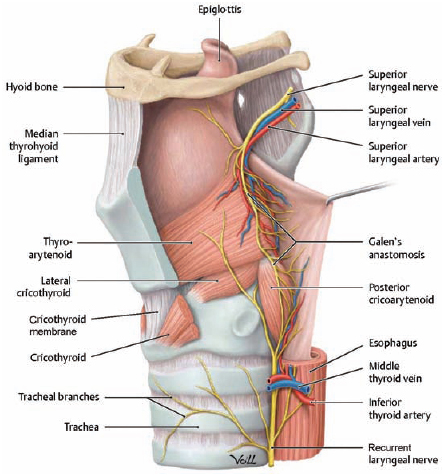
Fig. 2.21 Anterior-oblique view of the larynx with the thyroid cartilage removed demonstrating the course of the superior laryngeal nerve, vein, and artery and the recurrent laryngeal nerve along with the branches of the inferior thyroid artery and middle thyroid vein that supply the larynx. (From THIEME Atlas of Anatomy, Neck and Internal Organs, © Thieme 2006. Illustration by Markus Voll.)
 Conclusion
Conclusion
Familiarity with basic laryngeal anatomy is critical for the interpretation of laryngeal imaging studies. Clinicians familiar with normal laryngeal anatomy are able to detect alterations in the anatomy and functioning of the larynx due to pathology.
References
1. Busuttil A, Davis BC, Maran AG. The soft tissue/cartilage relationship in the laryngeal glottis. J Laryngol Otol 1981;95:385–391
2. Mu L, Sanders I. The human cricothyroid muscle: three muscle bellies and their innervation patterns. J Voice 2009;23:21–28
3. Damrose EJ, Huang RY, Ye M, Berke GS, Sercarz JA. Surgical anatomy of the recurrent laryngeal nerve: implications for laryngeal reinnervation. Ann Otol Rhinol Laryngol 2003;112:434–438
Stay updated, free articles. Join our Telegram channel

Full access? Get Clinical Tree


